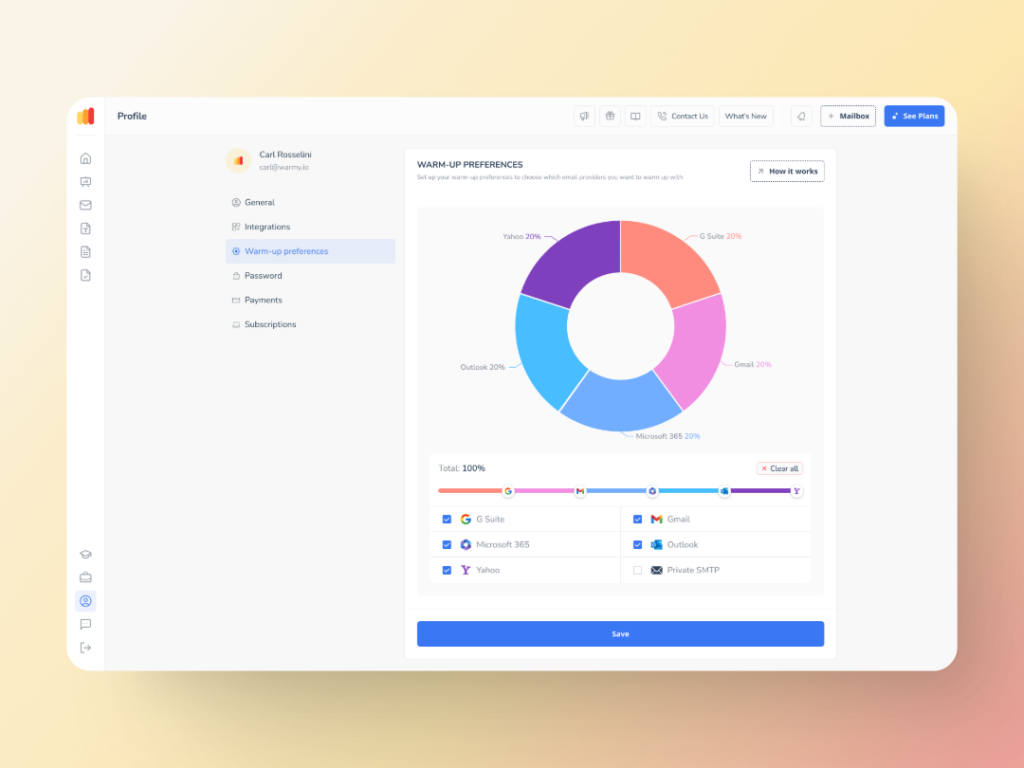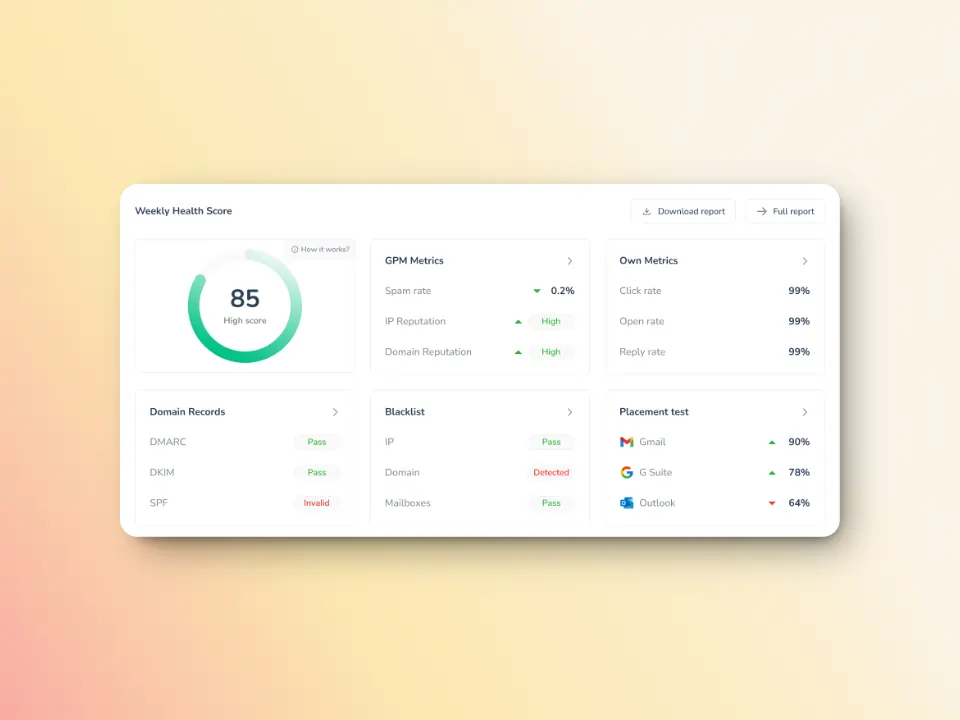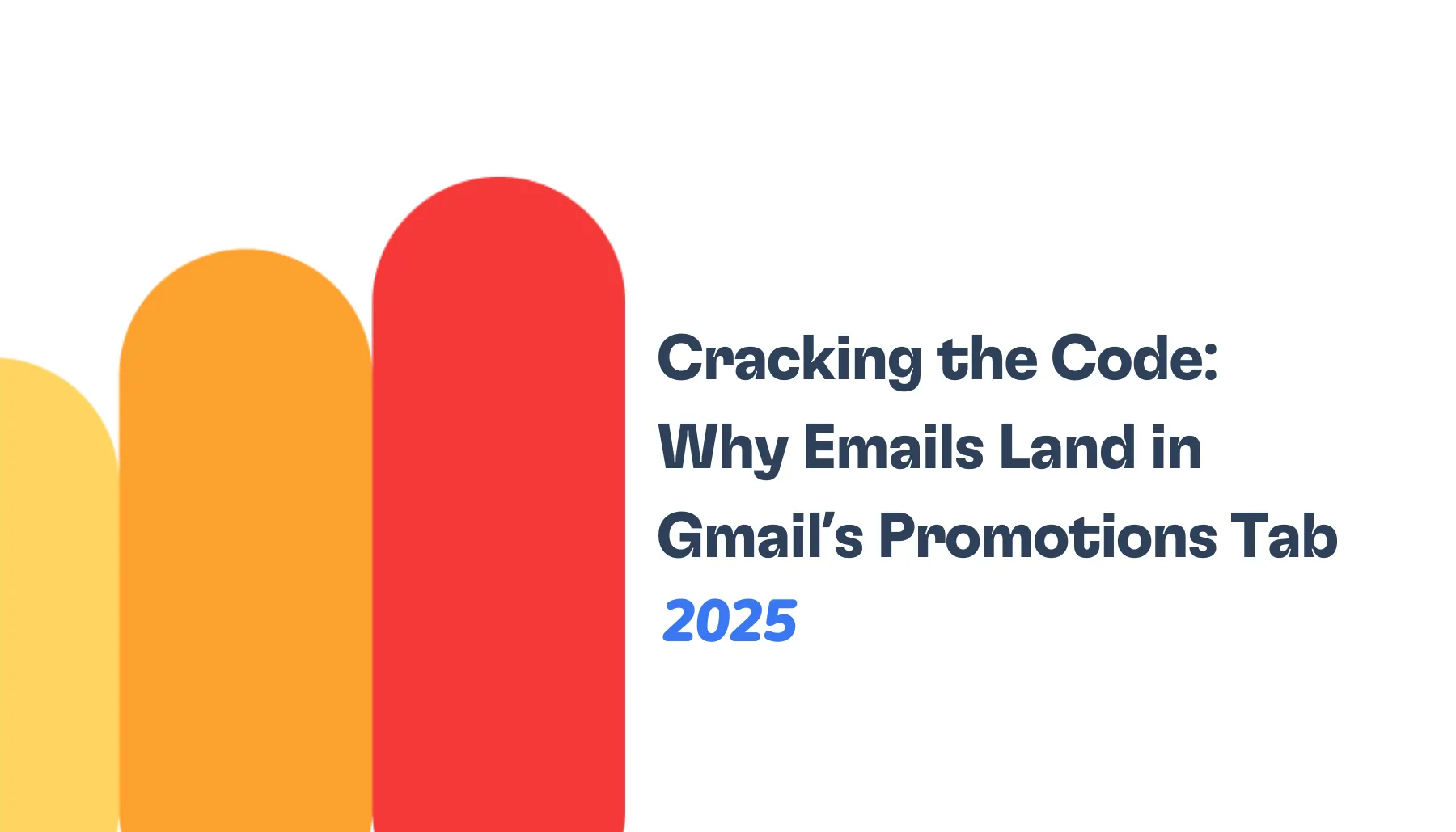Marketers with email campaigns in their toolbox know all too well that to be successful, it’s essential to launch a new domain—which is exciting. But if you start sending too many emails right away, they might just end up in the spam folder.
In 2025, email service providers (ESPs) have leveled up when it comes to security and strict spam filtering mechanisms. There’s no other way around it but to do it the right way: by warming up your domain before launching your first campaign or cold email.
If you’re a SaaS startup, eCommerce brand marketer, or B2B marketer, you’re in the right place. This blog is your step-by-step email warm-up checklist for new domains in 2025. We will walk you through every stage. You’ll learn how to prepare your domain, what to monitor, how to scale safely, and how tools like Warmy.io can automate the process with fewer risks.
Let’s make sure your domain starts strong—and stays out of the spam folder.
Why email warm-up matters for new domains
Before we discuss why warmup matters for new domains when it comes to email marketing, we need to answer one frequently asked question.
Q: Why do you need a new domain for outreach in the first place?
A: Using your primary business domain (the one your website and customer communications are already built on) for cold outreach is risky. If your outreach campaigns trigger spam complaints, high bounce rates, or poor engagement, your domain reputation can take a hit. Inbox providers could flag you and even blacklist your domain. This can then affect all emails sent from your company—including support emails, transactional emails, client communications, and even order confirmations.
🔖 Related Reading: Importance of Email Warmup before Cold Outreach
This is why smart brands and marketers create a new domain or subdomain dedicated solely to outreach. Then, they warm it up before sending any real campaigns. Done right, this protects your core domain while improving inbox placement, and increasing the chances of outreach success.
Here are other reasons why email warm-up is beneficial for new domains:
It helps you avoid the spam folder
When inbox providers identify that an email has been sent from a new domain, they treat it with caution. After all, there’s no sending history. There’s no credibility or authority—yet. So when a new domain sends bulk emails right away, inbox service providers may flag your domain or your email address as spammy and suspicious. When this happens, the next emails you will send have a higher chance of landing in spam or getting blocked.
Warming up your domain tells ESPs that you’re a legitimate sender. It introduces your domain gradually, using safe sending patterns and positive engagement signals like opens and replies. This builds trust over time—and trust is the key to staying out of spam.
🔖 Related Reading: The Warmy Research Team recently conducted an experiment to examine how different warm-up strategies affect the deliverability of emails from newly created domains. You can access the full report here: The Science and Process of Warming Up Newly Created Email Domains.
Building a positive sender reputation
Sender reputation is another factor that affects overall deliverability. So for new domains, this can be a challenge as they have no reputation yet. In the world of emails and inboxes, sender reputation is like a credit score. It is built over time and it’s based on how recipients interact with your emails and your domain.
A new domain starts with a neutral reputation. Warming it up helps shape a reputation positively from day one. Over time, inbox providers start recognizing your domain as safe and trustworthy. This will also help you improve deliverability in the long run. Skipping this step and blasting emails to large lists right away is one of the fastest ways to burn your domain—and your chance to reach inboxes consistently.
Ensuring long-term email deliverability
Email warmup isn’t just a one-time big-time project. It’s the foundation for long-term deliverability. A well-warmed domain continues to perform better, even as you scale up your campaigns. When done correctly, warm-up helps you:
- Get more emails into the primary inbox, not the spam or promotions tab
- Reduce bounce rates by sending to cleaner, more engaged contacts
- Increase open and reply rates, which further strengthens your reputation
- Avoid blacklists and maintain compliance with major email providers
Key takeaway: A good email warm-up is about building up your domain’s reputation slowly, steadily and cautiously. It’s how you earn the trust of inbox providers like Gmail, Outlook and Yahoo and get your emails delivered, opened and clicked. Remember, no amount of great content and design can save you from bad deliverability if you haven’t warmed up.
Pre-warm-up technical setup checklist
Let’s get one thing straight: email deliverability success takes a lot of factors into consideration. Before you start building out the actual content, you need to make sure that your domain is technically prepared to “warm up.” You may have the greatest email ever in your pipeline, and if it doesn’t make it to the inbox, it’s useless.
Even if you do go ahead with a warm-up process, it will not generate beneficial results if there are issues with the technical side. You don’t want to simply do a warm-up process for the sake of it. So before you start sending emails, take a step back to set yourself up for success.
Think of it as laying a solid foundation before building a house. This section will cover the necessary technical steps you should take to ensure that your emails have the best chance of reaching the inbox.
1. Register a clean domain
A clean domain means one that has no previous email reputation issues or spam complaints associated with it. This is important because email providers monitor domain age and previous reputation. Starting fresh allows you to build your reputation from the ground up without inheriting negative baggage.
Tip: Avoid using your primary business domain for cold outreach to prevent risking your current reputation. A subdomain dedicated to outreach is safer and more effective.
2. Set up essential DNS records (SPF, DKIM, DMARC)
When you register your domain, it’s a must to configure your DNS records. Think of these records as the instructions that email servers follow to verify that your messages are from a verified source.
- SPF (Sender Policy Framework): This lets email senders know which IP addresses are allowed to send emails on behalf of your domain.
- DKIM (DomainKeys Identified Mail): This includes a cryptographic signature in your emails to show that the content of the email wasn’t altered along the way.
- DMARC (Domain-based Message Authentication, Reporting & Conformance): This tells email servers what to do with emails that do not pass SPF or DKIM and lets you track how well your domain is doing with your mail.
🔖 Related Reading: SPF, DKIM, and DMARC: Boosting Email Security and Deliverability
3. Create a professional mailbox structure
- Use a professional naming convention for your mailboxes. Try to avoid using something generic or sketchy sounding like “sales123@” or “marketing@” as these can raise red flags with email providers.
- Use names that look like real people are sending the emails, such as “jane.doe@” or “john.smith@.” This is better for your email’s credibility and reduces the chances of getting marked as spam.
- Make sure you have an inbox just for outreach.This helps to separate cold outreach from other communication and gives you better control over your email health.
The must-have email warmup checklist for new domains
Now that your domain is set up and ready for action, it’s time to start the warm-up process. This checklist will guide you through the crucial steps needed to gradually build a positive reputation with email service providers (ESPs). By following these steps, you’ll ensure that your emails make it to the inbox and avoid spam filters.
Step 1: Set up inbox monitoring
Monitoring your domain’s inbox health is key to understanding how email providers view your messages. Setting up inbox monitoring tools helps you track your domain’s reputation and see how your emails are performing across different providers. This allows you to make adjustments early on if there are any signs of deliverability issues.
What to do:
- Use Google Postmaster Tools: Sign up and link your domain to Postmaster Tools to track your reputation with Gmail.
- Set up Microsoft SNDS (Smart Network Data Services): This tool lets you track your domain’s performance with Outlook and other Microsoft email services.
- Monitor with Warmy.io: Warmy offers a free deliverability test that gives senders an idea of their inbox placement rate across various ISPs.
2. Start with low volume sending
We get it—you’re excited. You’re brimming with lots of ideas for email marketing campaigns. However, “slow and steady wins the race” is also very much applicable when it comes to email warm-up and email outreach.
Starting with a low volume of emails and gradually increasing helps inbox providers recognize your domain as a legitimate sender. If you send too many emails too soon, you risk triggering spam filters .
Q: What are spam filters?
A: Spam filters are tools used by email service providers to detect and block unwanted or harmful emails, such as those containing spam, phishing attempts, or malware. They analyze various factors like sender reputation, email content, and engagement to decide whether an email should be delivered to the inbox or marked as spam.
What to do:
- Send 5-10 emails per day in the first week: These emails should be sent to engaged recipients, such as colleagues or test accounts.
Avoid sending to large lists immediately: Focus on high-quality, warm contacts rather than sending to bulk or unverified lists.
3. Prioritize engagement
Email providers care about engagement. If recipients are opening, replying, and interacting with your emails, your domain is seen as valuable and trustworthy. On the other hand, if your emails are ignored or marked as spam, your sender reputation can suffer. Ensuring high engagement early in the warm-up process is essential to building long-term deliverability.
What to do:
- Send personalized emails: Make your initial emails look personal and not too salesy. Personalized content tends to get higher engagement.
- Request replies: Encourage your recipients to respond to your emails. This shows ESPs that your emails are worth engaging with.
- Avoid large marketing messages: The first emails should not be newsletters or promotions. Focus on simple, conversational emails.
4. Ramp up sending volume gradually
Once you’ve warmed up your domain with low-volume sends, it’s crucial to increase your sending gradually if you ever hope to get to a point where you can send bulk campaigns. Rapid volume increases can overwhelm ESPs and result in your domain being flagged. A gradual ramp-up shows that you’re a legitimate sender, ensuring better inbox placement and reducing the likelihood of being blacklisted.
What to do:
- Increase volume by 10-20 emails per day each week: Gradually ramp up your email sends as you progress through your warm-up. Keep the list small but engaged.
- Monitor your bounce rates: If your bounce rate starts to increase, slow down your volume increase and investigate the cause.
- Gradually expand your list: Begin including people outside of your internal network, but ensure they’re still engaged (e.g., warm leads, subscribers).
🔖 Related Reading: Maximizing Email Deliverability: Grouped vs. Randomized Sending is another experiment by the Warmy Research Team where they tested two methods to analyze which approach leads to higher inbox placement and better engagement.
Take your warmup to the next level: Use a warmup tool to automate the process
While effective and very much recommended, manually warming up a domain can be time-consuming and error-prone. However, a dedicated email warm-up tool, like Warmy.io, automates the process—making it easier to do all of these things at the same time: increase sending volume, track engagement, and ensure that your domain is protected from potential deliverability issues. It also saves you from making manual mistakes that could hurt your reputation.
Here’s a quick list of how Warmy can help you achieve all of the things in the email warmup checklist:
Free SPF and DMARC Record Generators
As mentioned above, properly setting up your SPF and DMARC records is essential for email authentication which helps to establish your domain’s legitimacy. These records ensure that your emails aren’t flagged as suspicious by email service providers (ESPs).
Warmy has a free SPF Record Generator and a free DMARC Record Generator to help you quickly set up and verify these essential records for your domain. They ensure your emails pass the necessary checks, preventing deliverability issues right from the start.

AI-powered warmup process which can also be customized
Warmy offers a one-of-a kind AI-powered warm-up tool that takes the guesswork out of the process. It adjusts the volume and frequency of your sends based on your domain’s performance and reputation. Then, Warmy gradually increases the number of emails sent while ensuring that engagement levels are maintained for optimal deliverability.
With the recent addition of the Warmup Preferences, you can tailor the warm-up process to suit your specific needs, such as the distribution of the warm-up across providers and whether you prefer B2B or B2C engagement patterns.

Advanced seed lists for topnotch warmup quality
Email seed lists are crucial for simulating how your emails are received by different inbox providers. They allow you to test your email deliverability across a wide range of email clients, helping you fine-tune your sending strategy and ensure maximum inbox placement.
🔖 Related Reading:
- Email Warmup Alternatives: When Traditional Warmup Isn’t Enough
- Email Engagement How Seed List Helps Improve Open & Click Rates
Warmy offers the most advanced seed list technology. The seed lists include real email addresses from top providers (e.g., Gmail, Yahoo, Outlook), allowing your emails to be tested against these widely used platforms. Plus, the quality of the warm-up is unparalleled as Warmy offers genuine engagement. Emails are opened, scrolled through, clicked on, and replied to. If there are emails that land in spam, these are removed and marked as important to let the ESPs know you are credible.

Comprehensive set of insights to keep you on your toes
The email deliverability test already provides a huge chunk of crucial data. But the Domain Health Hub inside the Warmy platform is something else.

The Hub enables senders to:
- Check the percentage of emails reaching the primary inbox, spam folder, or promotions tab.
- Get a clear view of warmup performance insights like spam rates, inbox placement, and deliverability trends on a weekly & monthly basis
- Scan your domain/IP against major email blacklists (Spamhaus, MXToolbox, etc.).
- Monitor deliverability at the domain level from one dashboard to easily identify which needs attention
- Get comprehensive DNS status checks to easily validate SPF, DKIM, DMARC, rDNS, MX, and A records for stronger authentication & security
Start warming up the smart way with Warmy.io
Launching a new domain for email outreach is a critical step in your marketing strategy, and warming it up correctly is key to ensuring your messages make it to the inbox. With Warmy.io, you can automate this process, saving you time, avoiding common pitfalls, and protecting your sender reputation.
You can confidently scale your outreach while maintaining a strong reputation with email providers. The smart way to warm up your domain is with the right tools—tools that take the guesswork out of the equation. Your email deliverability in 2025 is definitely looking up!
Don’t let your domain get lost in the spam folder. Start warming up today with Warmy.io and take your email outreach to the next level.











